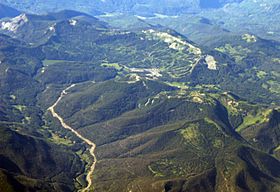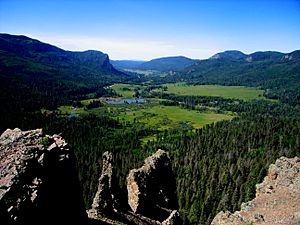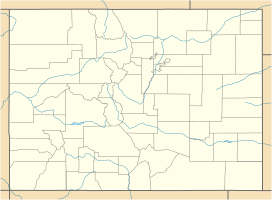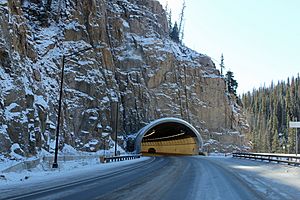Wolf Creek Pass facts for kids
Quick facts for kids Wolf Creek Pass |
|
|---|---|

Wolf Creek Pass and Ski Area, August 2008
|
|
| Elevation | 10,857 ft (3,309 m) |
| Traversed by | |
| Location | Mineral County, Colorado, United States |
| Range | San Juan Mountains |
| Coordinates | 37°29′00″N 106°48′11″W / 37.48333°N 106.80306°W |
| Topo map | USGS Wolf Creek Pass |
Wolf Creek Pass is a very high mountain pass in the San Juan Mountains of Colorado. It sits on the Continental Divide, which is like the backbone of North America. Rain and snow that fall on one side of the Divide flow to the Pacific Ocean. On the other side, they flow to the Atlantic Ocean.
This pass is part of U.S. Highway 160. This highway connects the San Luis Valley to southwest Colorado. From there, it continues towards New Mexico and Arizona. Wolf Creek Pass is famous because a song was written about it.
The road over the pass is very steep. It has a maximum grade of 6.8%. This means for every 100 feet you travel horizontally, you go up or down 6.8 feet. This can be dangerous, especially in winter. There are special ramps called runaway truck ramps. These are for big trucks that might lose control of their brakes while going downhill.
Contents
Traveling Wolf Creek Pass

Wolf Creek Pass used to be a narrow, two-lane road. It wound through the San Juan Mountains between South Fork, Colorado, and Pagosa Springs. Now, it has been made wider with more lanes. This helps more cars get through. It also makes driving safer in bad weather.
This pass is the easiest way to reach southwest Colorado from other parts of the state. Other routes are much longer. They might go through New Mexico. Or they might go over Lizard Head Pass near Telluride. Another challenging route is Red Mountain Pass. This road is very narrow and winds along steep cliffs.
History of the Pass Road
Work on the first road over Wolf Creek Pass started in 1911. It was finished in 1916. The engineers who designed it were J. E. Maloney and Ed Riley. This first road was 12 feet wide.
In 1930, the road was made twice as wide. Twenty years later, in 1950, it was paved. A new tunnel was built on the eastern side of the pass. This tunnel is about 900 feet (274 meters) long. It opened on November 5, 2005. The whole project to widen the highway and improve drainage was finished in the summer of 2006.
Fun Things to See
The Lobo Overlook is a great spot to visit. It is 11,760 feet high on the north side of the pass. From here, you can see amazing views of the Continental Divide.
The pass is also home to the Wolf Creek ski area. This ski resort is on the eastern side of the Continental Divide. It is right on Highway 160. Also on the eastern side is one of the biggest RV parks in the United States. It is just a few miles west of South Fork, Colorado.
Many tourists come to Wolf Creek Pass to see the beautiful nature. The highway goes through stunning wilderness. Just west of the pass, you can see Treasure Falls. This is a beautiful mountain waterfall.
How the Pass Got its Name
The pass is named after Wolf Creek. This creek starts near the very top of the pass. It flows down the western side. Then it joins the West Fork San Juan River in Mineral County.
The C. W. McCall Song
Wolf Creek Pass became very famous in 1975. This was because of a song by country music artist C. W. McCall. The song is also called "Wolf Creek Pass." In the song, the pass is described as "37 miles o' hell – which is up on the Great Divide."
The song tells a funny story about a truck. The truck goes speeding down through a "tunnel." During this wild ride, several crates of chickens fall off the back! The truck eventually crashes into a feed store in Pagosa Springs.
Climate and Weather
Wolf Creek Pass has a cold climate, like a subarctic climate. It gets a lot of rain and snow all year round. Because it is so high up, it's also called a subalpine climate.
Summers here have mild days and cool nights. Winters are very cold. Nightly temperatures often drop close to zero degrees Fahrenheit. Winter weather can last from early November until April. The pass gets a lot of snow. It averages about 435.6 inches (1,106 cm) of snow each year. This is one of the highest amounts in all of Colorado. Snow usually starts falling by late September. It can keep snowing until early June. March often has the most snow on the ground, around 67 inches (170.2 cm).



